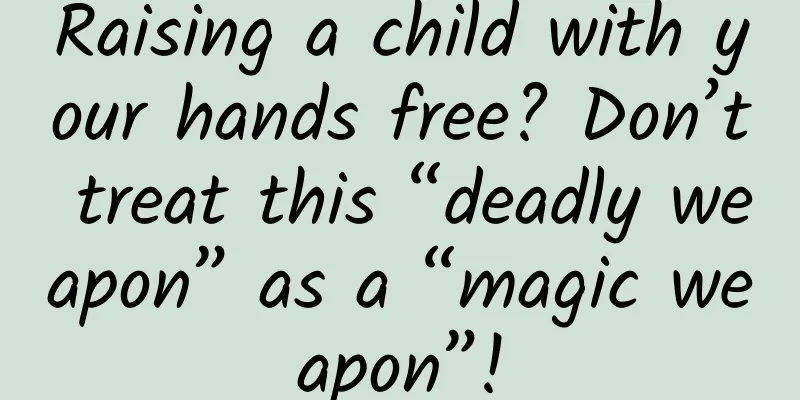Raising a child with your hands free? Don’t treat this “deadly weapon” as a “magic weapon”!

|
Just one month ago, on May 16, US President Biden signed the Infant Safe Sleep Act of 2021 (HR3182), which requires a ban on the manufacture and sale of sleepers and some crib bumpers with an inclination angle greater than 10 degrees for children under one year old. As a dad who always protects his children, we talked to parents about the risks of baby sleeping chairs as early as 2020. Two years have passed, and more and more parents have paid attention to us, and many old fans have become new parents. As the new bill is signed, we would like to emphasize once again the risks of infant sleepers and crib bumpers that are also banned. This is related to the safety of children's lives, and it is never too much to say it. 01 Sleeping artifact The manufacture and sale of baby sleeping chairs for children under one year old with a tilt angle greater than 10 degrees will be banned in the United States. Known as the new generation of "sleep-coaxing artifact", they not only free parents' hands, but also allow children to enjoy an "immersive" sleep-coaxing experience. This is very appealing to parents who are exhausted from trying to get their children to sleep every day. However, as early as 2019, the three major brands in the United States began to recall baby sleepers. From 2015 to 2019, a total of 1,108 baby sleeper safety incidents occurred, resulting in the unfortunate deaths of 73 babies. During the 618 shopping festival this year, parents in the company saw recommendations for baby sleeping chairs when they were stocking up on supplies for their kids. Compared with the simple manual rocking chairs of the past, merchants have upgraded to smart electric models. The biggest problem with seemingly safe and high-tech baby sleepers is that the surface of these sleeper chairs is relatively soft, and the tilted angle and shaky backrest make it difficult for babies to turn over on their own. This is very likely to result in the baby being unable to flip over, and eventually suffocating due to lack of oxygen, leading to death. This suffocation risk requires parents to stay by their children's side when they use the recliner. Many recliner product detail pages also remind you of this: It is difficult for us to concentrate when we see our children sleeping peacefully, and danger often occurs just because of a moment of negligence. Therefore, we recommend that everyone, especially babies under 1 year old, avoid using such products, let alone using them as cribs for nighttime sleeping. We also understand that many parents have a hard time taking care of their children, and they buy baby sleeping chairs just to free their hands and take a breath and rest. At this time, we can put the child in a crib or a qualified playpen, so that someone who does not often take care of the child at home can share the pressure of taking care of the child. 02 Baby crib bumper Some crib bumpers are also banned in the bill. The banned crib bumpers are padded cushions used to cover the side slats of a crib to prevent the baby from being hit or falling into the side gaps of the crib. Who wouldn’t be confused by a crib guard that looks good and protects the child? Don’t want to place an order right away? But there is currently no evidence that products such as crib bumpers can help reduce child injuries. Instead, the baby could get stuck in the cushion and suffocate. Additionally, older toddlers may use the crib rail as a support point to climb out of the crib, posing a risk of falling. According to the American Academy of Pediatrics (AAP), crib bumpers have been linked to more than 100 infant deaths in the past 30 years. 03 Sudden Infant Death Syndrome The cause of infant death caused by sleep aids and crib bumpers is sudden infant death syndrome. Sudden infant death syndrome, also known as "cradle death," occurs most frequently in infants between 2 weeks and 1 year old, and almost all infant deaths occur during sleep. Because babies have not yet learned to roll over, cradles, padded crib rails, and soft objects on the bed may cause accidental suffocation and death. From a safety perspective, the American Academy of Pediatrics recommends that infants under the age of 1 should sleep on their backs in a flat, firm position. Studies have shown that infant mortality rates have dropped by 70% in areas where this sleeping method is adopted. 04 Tips for a good sleep The baby sleeps well and parents worry less. In order to make the child sleep safely and comfortably, it is recommended that you do this: Where does your child usually sleep? How long does it take to coax him/her? What other children's products are you interested in? Welcome to chat in the comment section! Editor | Tang Tang Design | Sour References https://www.healthychildren.org/English/ages-stages/baby/sleep/Pages/Inclined-Sleepers-and-Other-Baby-Registry-Items-to-Avoid.aspx https://www.healthychildren.org/English/ages-stages/baby/sleep/Pages/A-Parents-Guide-to-Safe-Sleep.aspx https://www.healthychildren.org/English/ages-stages/baby/sleep/Pages/Sleep-Soundly-While-Baby-Sleeps-Safe.aspx https://www.congress.gov/117/plaws/publ126/PLAW-117publ126.pdf |
Recommend
High imitation Baidu Nuomi
Source code introduction: High imitation of Baidu...
When you are in the world, you will inevitably get hurt! Let's take a look at the things about scars
Figure 1 Copyright image, no permission to reprin...
Moto X 3rd generation high-end version review: balanced and cost-effective flagship
Motorola Mobility, a subsidiary of Lenovo, today ...
Why does winter make people want to fall in love?
© unsplash Leviathan Press: A few months ago, Mat...
Southerners: Why do we need to scrub our bodies? Northerners: It can remove dead skin cells!
Tell me quietly, are you from the north or the so...
Is the smart wearable industry really failing? Or is it just because your product is not good enough?
Do you think that after the decline in iPad sales...
A liberal arts scholar who doesn't know calculus turns into a professional mathematician and creates his own toys to reveal natural wonders
I don't think my life is unconventional. Of c...
Can JD.com’s smart home layout last long-term?
In the third week of March, JD.com, which occupie...
Exclusive interview with Zhou Hongyi: Smartphones will become the interface for the Internet of Things
[[128433]] Editor’s Note: I just want to say quie...
After spending money, how can we judge the effectiveness of promotion?
You know that half of your advertising budget is ...
How much does it cost to make an electrical applet in Shangluo?
How much does it cost to produce the Shangluo Ele...
The trillion-dollar new business model of smart cars is driven by billions of sensors that you don’t know about
If electrification is the first half of the autom...
National Development and Reform Commission: From January to February 2025, the national new energy passenger vehicle retail sales will be about 1.34 million, a year-on-year increase of 26%.
At a press conference held by the State Council I...
The Earth's rotation is getting faster and faster. Is the Earth also "in a hurry"?
Recently, the earth has been "acting" l...
A famous singer died of cancer! This cancer "prefers Chinese people", so hotpot lovers should be extra careful...
On December 5, the famous Japanese band The Birth...









